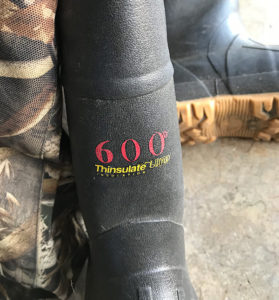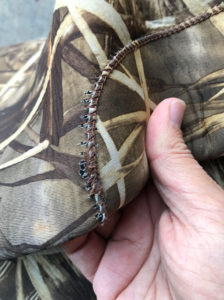Waders are one piece of clothing that’s nearly mandatory for duck hunting and for some forms of fishing. They allow you to set and retrieve decoys as well as downed ducks while keeping you dry throughout the hunt.
They are generally found in two categories: neoprene and “breathable”.
I’ve created this guide to help you decide which might be right for you and to give you some tips on what to look for when buying them.
Neoprene Waders
Neoprene is a synthetic rubber that is relative thick and cushioned. It stretches and generally has a snug fit. Neoprene waders can be found at nearly any outfitters and at local sporting goods stores, often in waterfowl style camo.
Pros
- Waterproof
- Warm, Good for Cold Weather
- Harder to Field Patch
Cons
- Too Warm at Times
- Seals Can Fail Quickly Depending on Type of Sewing and Reinforcement
- Rubber Snags Easily on Thorns
- Bulky
Breathable Waders
Breathable waders are made of a synthetic, lightweight material, which differs slightly among manufacturers. They are much lighter weight than neoprene but their this structure can lead to easy punctures.
Pros
- Waterproof
- Light
- Easy to Patch in the Field
- Cooler
- Versatile – Easy to Layer Underneath
- Resistant to Snagging
Cons
- Not Warm Enough for Really Cold Weather / Water
- Thin Material Can Puncture Easily
As you can tell by my “Pros and Cons” I would pick breathable waders over neoprene in most cases. The only time I would consider neoprene is if I did most of my hunting in very cold weather or water. Even then I would be tempted to stick with breathable waders. If you buy your breathable waders a little loose, you can layer socks, base layers, and sweaters and jackets underneath them.
Warm vs Cold Climate
The only time I would choose Neoprene over breathable would be for really cold weather or climates. You can get Neoprene in thicknesses of 3.5mm or 5mm, depending on how warm you need to be. In warmer climates where you might only see a handful of hunts in near freezing weather, breathable would be my choice.
Insulation in the Boots

When combined with a good pair of wool socks, these 600-gram insulated boots are just fine for our Pacific Northwest winters.
Many waders come with extra insulation in the boots, often in a product called Thinsulate™. This is an area where, again, you might consider your climate. A higher number of Thinsulate™ means the boots have more insulation in them, making them warmer. My old neoprene waders came with 1,000-gram insulated boots, while the breathable ones had 600-gram insulated boots. With the right kind of wool socks I can say in my area the difference has not been all that noticeable.
Choosing Fit
Choose your waders first on how the boots fit. Then pay attention to the rest of the fit. If you’re a larger guy, then you can choose “stout” waders. Neoprene is designed to fit tighter and gets really bulky when loose. I can even hinder your movement if you don’t get the fit right. I chose a looser fit for the breathable waders because it’s easier to layer clothing underneath them.
Seams
Over time, the seams on waders will give you the most trouble with leaking, resulting in drips that make their way into your boots. My cheaper neoprene waders’ seals are not joined particularly well and the stitching pulls apart. This causes the welded seals on the inside to weep or drip. My breathable waders, on the other hand, have better seals with more tape and sealant. After two seasons, they, too, are starting to weep and will require repairs. Try to find a pair within your budget that has better than average welded, taped and otherwise sealed seams.
Care and Storage
After each hunt it’s good to dry the inside of the waders to keep them from smelling bad. I use a simple boot dryer with extensions for this. Store your waders indoors to prevent them from getting too hot or dry. For neoprene, I hang them upside down by the boots up to minimize strain on the seams. These keeps them from folding and drying out too much would could result in weak points in the neoprene that would crack or tear. My breathable waders, which are a Cabela’s brand, can be dried then stored folded in a large tub.
Repairing
There are many products and ways to repair waders, but I think I’ve found a way to patch both neoprene and breathable with something that works.
Price
Basic neoprene waders can cost $100 or less but don’t expect these to last much longer than a season or two without extensive repairs. Breathable waders can cost nearly twice as much and mine made it through a couple of seasons before I had to seal the seams again.
Hybrid Waders
Recently some hybrid waders have come on the market. These have neoprene up to the waist and then breathable material up top. I’m not sure how effective these will be in keeping you from overheating and it will be interesting to see how people like them over the years.
Where to Shop
- Cabela’s – Best online selection and reviews
- Amazon
- Bass Pro Shops


1 Comment. Leave new
Hey i bought a pair of neoprene wafers from Tidewe for this my first season of duck hunting and the reason why I did was bc I paid 90 for them, they fit right (buy size down) and bc I live in northeast and expect very cold weather. The clincher for me though was seeing how buoyant they are if God forbid I were to fall into the water out of my kayak. Every video I’ve seen shows that the neoprene waders don’t let any water in once you fall in – creates like a water tight seal and actually serves as a secondary flotation device besides your life jacket. But, like you said, let’s see how long they last. I’m gonna try to stay in my kayak as much as possible and use them more like an insurance policy than anything else.